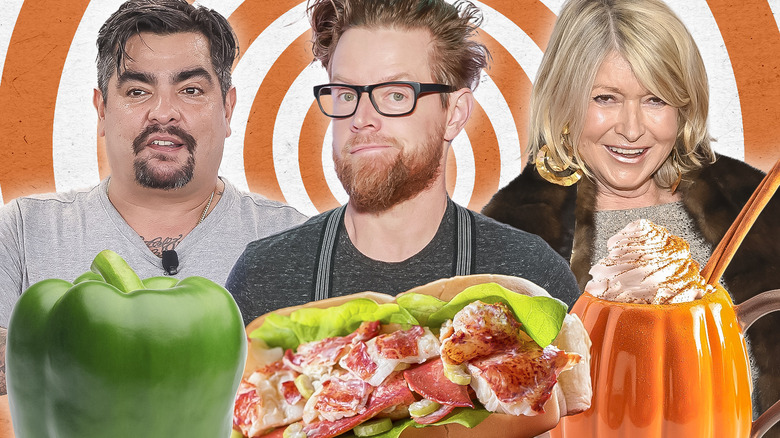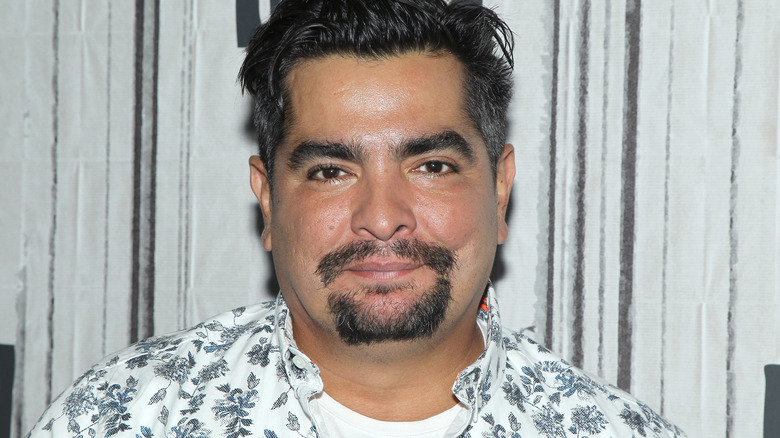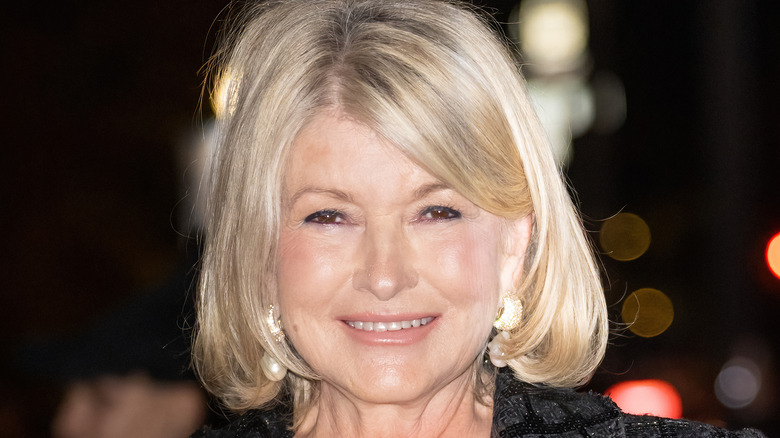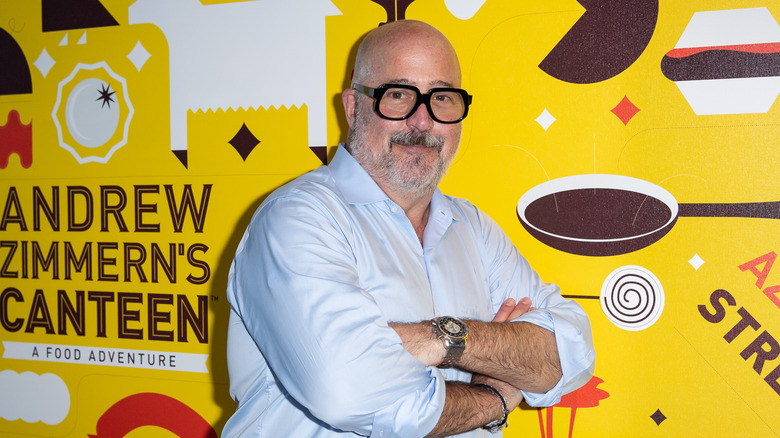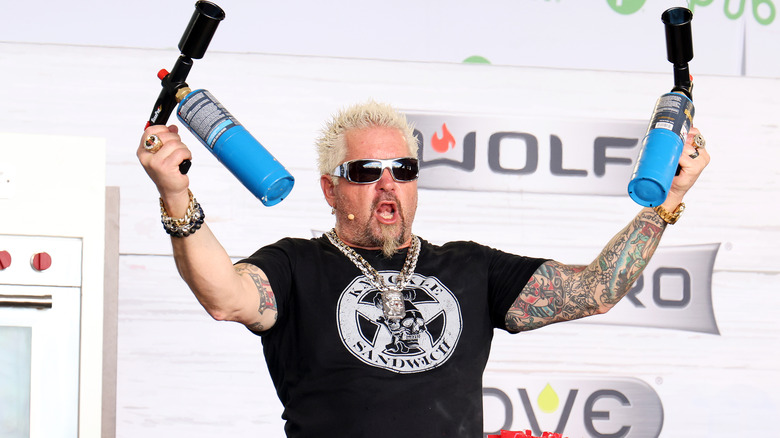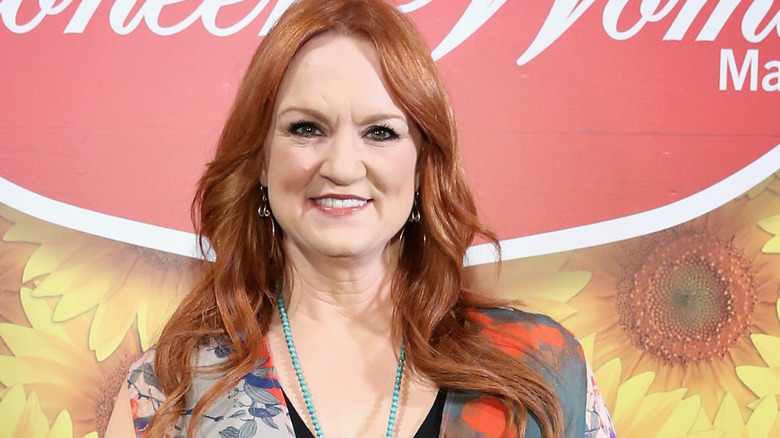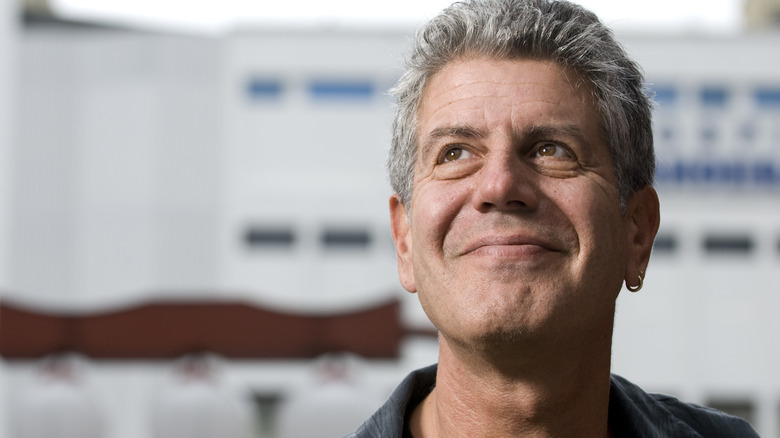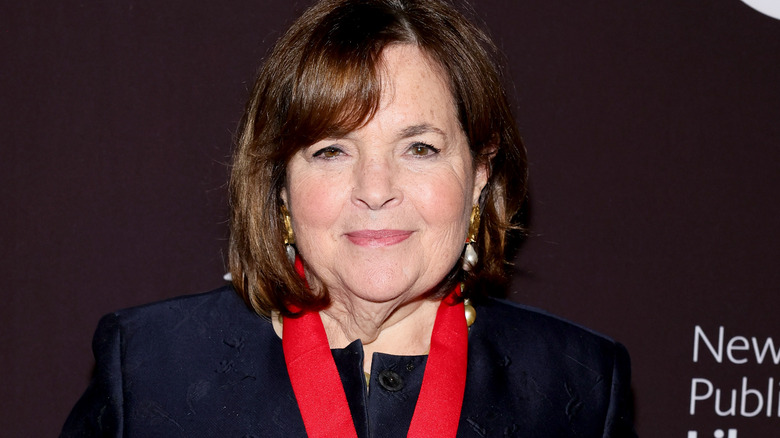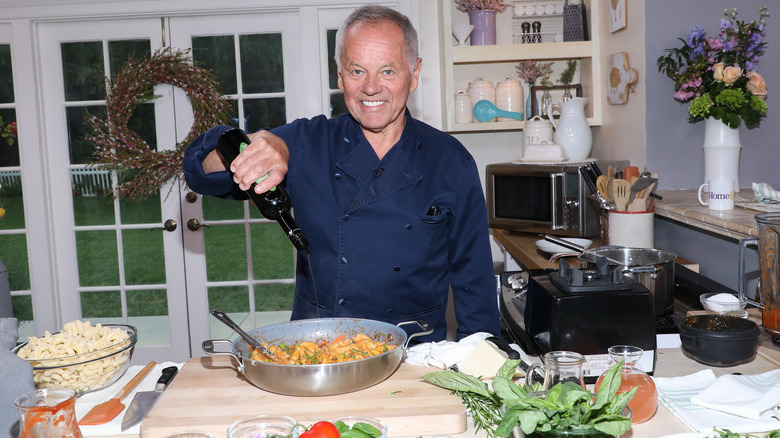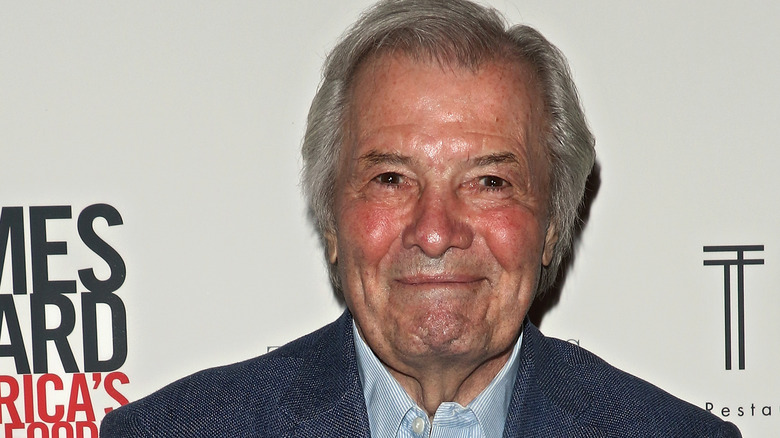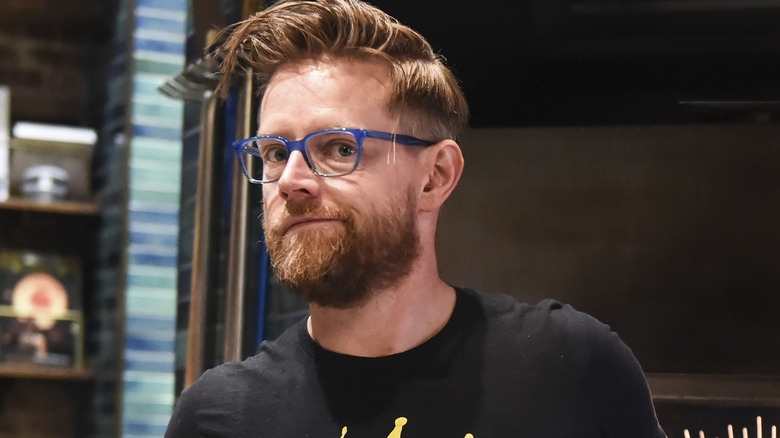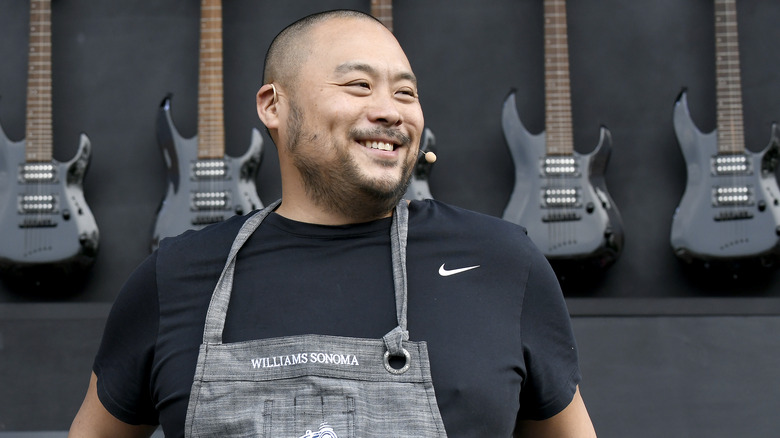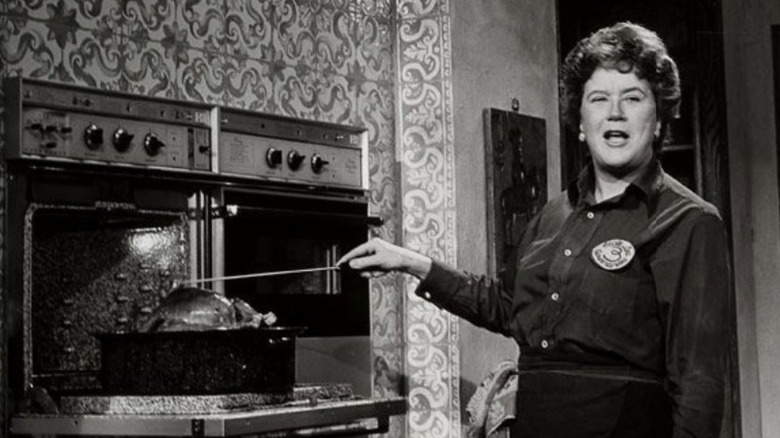Celebrity Chefs Who Have Controversial Opinions On Popular Food
Celebrity chefs are some of the most adventurous eaters on the planet, and just like us, they have a unique set of eating preferences. For instance, globe-trotting foodie Andrew Zimmern will happily eat bugs but has expressed straight-up revulsion toward basic ingredients. Anthony Bourdain, who introduced audiences to the vast and wonderful world of global food, waxed poetic over his love for a simple dish you can get at a drive-thru.
Many celebrity chefs become well-known by specializing in a specific cuisine or cooking in a signature style that leads us to believe we know what they eat off-camera ... which of course we don't. We've heard rumors that a certain TV chef doesn't eat their own food during a long day filming cooking segments, but it's harder to believe that a famous chef would promote recipes containing foods they can't stand — but it does happen.
Want to know which culinary experts have thumbed their noses at food trends or what to expect if David Chang invites you to a backyard barbecue? From quirky hangups and guilty pleasures to strong ideas about how foods should be prepared, here are the celebrity chefs who have controversial opinions on popular food.
Aarón Sánchez likes bell peppers, just not the green ones
Aarón Sánchez, the renowned chef and longtime judge of "MasterChef" and "MasterChef Junior" knows about good food. Sánchez uses his platform to champion Latino cuisine and preserve the rich culinary culture of his Mexican roots, but don't expect to see him munching on green bell peppers — he really doesn't care for them. During a Q&A with Food Network, the James Beard Award winner specified that it's not all bell peppers he takes issue with, saying, "I like red bell peppers and yellow bell peppers, but green bell peppers just don't taste like much of anything." Fair enough.
The menu at his New Orleans restaurant Johnny Sánchez follows the chef's preferences. Green bell peppers are not prominently featured in any of the dishes. Still, green bell peppers do make the cut in a couple of his recipes. His chicken fricassee incorporates one red and one green bell pepper and his huitlacoche salsa calls for a bell pepper medley — with green being among the indicated colors. Bell peppers are common in Latin American, Southwestern, and Mexican cuisines, which have all influenced Sánchez's food. In the past, Sánchez has said he doesn't want to be a chef who only cooks what he wants to eat, so green bell peppers may make it into his kitchen from time to time.
Martha Stewart thinks pumpkin spice is overhyped
Pumpkin spice has been the supreme deity of fall flavors for as long as we can remember and has been incorporated into everything from coffee creamer to body wash. Martha Stewart is over it, and since she does a holiday spread like no other, we trust her stance. When speaking to documented pumpkin spice hater Al Roker on the Today Show, Stewart sided with Roker and explained, "In a pie, I love it. In anything else, I do not love it ... I don't like cappuccino with pumpkin spice in it, I just don't".
Stewart famously resides on a 150-acre farm estate in Bedford, New York. Someone like Stewart, who routinely prepares large-scale dinner parties using food from her garden, simply has no use for the frivolous artificiality of pumpkin spice flavoring. For one, it's not even pumpkin flavoring that everyone is fanatically eating, drinking, and smelling. Pumpkin spice is little more than a blend of allspice, cinnamon, cloves, ginger, and nutmeg, plus all of the sugar and chemicals added to make the pumpkin spice sauce that's pumped into lattes and other festive beverages as the fall season approaches. Stewart is right — this aromatic spice blend belongs in a scratch-made pumpkin pie. It would also be great in some scratch-made pumpkin doughnut muffins ... made with Stewart's original recipe of course.
Andrew Zimmern will not indulge in cookie dough — especially if there are walnuts inside
When you're a celeb chef who has been filmed eating tarantulas, duck embryos, and grubs, people probably assume you'll eat absolutely anything. This is not the case for "Bizzare Foods" host Andrew Zimmern. The man loves to go in on a plate of bugs and other left-field delicacies but he has his limits. In fact, Zimmern would prefer a serving of roasted giant bat over a fistful of walnuts any day. And don't get him started on cookie dough.
In a 2017 post on X (formerly known as Twitter), Zimmern rattled off some foods he hates, including walnuts, raw cookie dough, and hot oatmeal. Seeing as these are foods that most people like, Zimmern had a little explaining to do. In a People magazine exclusive, Zimmern said that he doesn't eat walnuts or raw cookie dough simply because he can't stand them. He justified his unconventional opinion by saying, "I love fermented walrus anus, so I get to not like some things." Fans still wanted to know just what it was about seemingly ordinary walnuts and cookie dough that Zimmern was unable to get past. An earlier Tweet from 2011 resurfaced in which Zimmern commented that to him, walnuts taste soapy. As for his controversial views on raw cookie dough, the risk of foodborne illness has nothing to do with it. He just hates the texture.
Guy Fieri gets antsy around egg yolks
Guy Fieri is known to bring his large appetite and personality to every public appearance — unless egg yolks are present. In a 2012 episode of "Diners, Drive-Ins and Dives" Fieri visited Pizzeria Lola in Minneapolis with local resident and friend Andrew Zimmern. One of owner Ann Kim's signature pizzas comes with sunny-side-up eggs running over the top. As Chef Kim prepares to glide a pizza cutter through the eggs to make the yolks run, the normally eager Fieri yelps like a child afraid to pull off a bandaid, before turning his back to avoid the sight. He returns to the table notably still and straight-faced, hesitant to eat what he calls "liquid chicken" while a glowing Zimmern insists he should "man up". There is no footage of Fieri biting into the slice.
Recalling the episode in an interview with the Tampa Bay Times, Fieri explained his egg yolk aversion. "Hard-boiled and scrambled — that's just not the way I like to party. My wife will sit there and bust that yolk and scoop with the bread and the whole thing and ... " The TV chef and restaurant owner claims his squeamishness stems from a traumatic incident he had as a 10-year-old that involved cracking an egg and finding a fully-formed chick inside. The Mayor of Flavortown happily chows down on adult chickens and foods with eggs as an ingredient, but even after all these years, the mere sight of egg yolks proves triggering.
Ree Drummond refers to bananas as weird slimy things
Ree Drummond has never eaten a whole banana, although she's fine with you doing it — and will even provide the recipe. The Pioneer Woman celebrates the quaint, family meal aspect of cookery on her long-running Food Network show and through her bestselling cookbooks. Drummond understands that the scent of freshly baked banana bread wafting from the kitchen makes a house a home, and she's not trying to cheat her audience out of that just because she really, really hates bananas.
When she published a banana-friendly recipe, Drummond prefaced it with a full disclosure of how much she despises "the weird, slimy things". Under the Bananas Foster recipe on The Pioneer Woman website, Drummond wrote, "I hate, abhor, loathe, and recoil at the sight of bananas. I've disliked them my entire life, even when I was a baby." Yet she was forthcoming about an instance where she ate three slices of banana bread her mother baked explaining, "I'm certain it was because I had just finished a no-carb diet and had a skewed sense of taste. It had never happened before, and it hasn't happened since". Drummond has a sense of humor about her banana-hating ways. She posted the recipe for her mother's notorious banana bread on her website (along with another disclaimer) and maintains that she is "unabashedly anti-banana. I wear it like a badge".
Anthony Bourdain loved Popeyes and KFC mac and cheese
He's brought the joys of international street food into public consciousness and ate some questionable things in the process, but as daring an eater as Anthony Bourdain was, one humble food remained close to his heart. Bourdain opened up on numerous occasions about loving fast food mac and cheese.
Bourdain's favorite proprietor of fast food mac and cheese was Popeyes, with KFC coming in a close second. In a 2015 discussion with fellow culinary legend Jacques Pépin at the 92nd Street Y, Bourdain admitted that he would disguise himself with a hooded sweatshirt and sneak to the nearest Popeyes to order "that nasty macaroni and cheese ... that nuclear orange stuff and it's microwaved and I just love that stuff." He later revealed that his Popeyes mac and cheese cravings typically hit him in the morning hours.
If he couldn't get to Popeyes for a breakfast mac and cheese, Bourdain's backup plan was to hit up KFC. On a 2016 episode of "Conan", Bourdain admitted that any celebrity attention he received during these guilt-tinged KFC visits was like being "caught by a neighbor coming out of like, a strip mall porn shop." Bourdain often dissed fast food restaurants, but the confessional, self-deprecating humor surrounding his quick-service mac and cheese habit made it clear he was in on the joke.
Ina Garten gives Harvard beets a hard pass
There is one item that Ina Garten refuses to eat: Harvard beets, which she has hated since she was a child. In a 2022 episode of "The New Yorker Radio Hour", Garten shared some details about her childhood family dinners that painted a much different picture than the welcoming kitchen environment she cooks in today. At the table, Garten's father would quiz her on schoolwork between bites of canned peas, boiled chicken, and Harvard beets. Garten mentioned that these dinners never included a carb element like bread or potatoes, but the Harvard beets added insult to injury. "No child likes Harvard beets. You might develop a taste for it afterward, but not when you're 10."
Harvard beets differ from regular canned beets or pickled beets because they are cooked in a sweet and sour-esque sauce of vinegar, sugar, cornstarch, and butter. Early 20th-century recipes for Harvard beets offer variations like adding salt and pepper or cloves. Either way, you won't find this old-timey recipe in any of Ina Garten's cookbooks.
Wolfgang Puck isn't impressed by Wagyu beef
We're all for celebrity chefs indulging in fine foods, be it dollops of high-end caviar, layers of freshly shaved truffles, exquisitely marbled cuts of Wagyu beef, or maybe even all three. One culinary titan who isn't enchanted by Wagyu beef is the veteran chef to the stars and famed restaurateur Wolfgang Puck. Among his many achievements, the Austrian-born chef is the proud owner of CUT, a small international chain of luxury steakhouses where Wagyu beef is a fixture on the menu — but not because Puck loves the stuff, it's simply an industry standard.
What are Puck's problems with Wagyu all about? Mainly, he thinks it's way too fatty. Wagyu means "Japanese cow" and is a cattle breed from Japan prized for the intense fat marbling of its meat. Wagyu is regarded as the finest beef money can buy, unless you're talking to Wolfgang Puck. Wagyu enthusiasts cite the meat's high fat content for contributing to its decadent flavor and melt-in-your-mouth tenderness, whereas Puck finds it unappealing. America and Australia have their own versions of Wagyu beef, meaning that the cows are genetically similar to those hailing from Japan but are not raised there.
Puck may not crave pure Wagyu, but he's always up for some quality steak. His favorites include American dry-aged rib-eye and New York sirloin made from a cross-breed of Wagyu and Black Angus cattle — which goes to show that a little Wagyu can go a long way.
Jacques Pépin puts ketchup on his meat
French chefs have had a tremendous impact on the culinary world and one of the country's brightest stars is the incomparable Jacques Pépin. After finding early success as a chef in his native land, Pépin moved to the United States, where he became one of PBS' most-loved TV chefs. Does it surprise us that a class act like Pépin puts ketchup on his meat? Yes. Do we adore him anyway? Absolutely.
Slathering beautifully cooked meat with ketchup has long been viewed as a fine dining faux pas, but now that we know Jacques Pépin is into it we're starting to think it's not that bad. Pépin maintains that ketchup, or at least thick tomato sauce, has been a French cooking staple since way back. He notes that ketchup's texture and tanginess create a nice balance of sweet and savory in a protein-forward dish. More than a few of Pépin's popular recipes call for ketchup-based glaze, including his Lyon-style chicken thighs, spicy maple-glazed ham, and baked salmon with sauteed endive.
Keep in mind that a consummate professional like Pépin would never drown a protein of any kind in straight ketchup. He uses the simple ingredient with the utmost refinement, always jazzing it up with supporting players like maple syrup, sriracha, or something else to bring out the condiment's sweet and spicy notes. What can we say? We trust this man.
Richard Blais takes a side in the great lobster roll debate
"Top Chef" alum and culinary mentor of "Next Level Chef" Richard Blais is a Long Island native living in Southern California, yet he's got some controversial opinions on one of New England's most divisive food debates. Ask someone in Maine how lobster rolls ought to be made and they'll swear that a traditional lobster roll involves mixing lobster meat with mayo, stirring in a sprinkle of celery for crunch, and scooping it into a split-top hot dog bun (also called a New England hot dog bun). Most Connecticut dwellers will insist that warm lobster meat lightly coated in drawn butter and served inside a toasted, buttered, split-top hot dog roll is the only way to go. So where does Richard Blais stand?
He stands with team Maine. Blais admits, albeit with some trepidation, that he prefers the cold lobster salad with mayo, but his own lobster roll recipe tip-toes into Connecticut's territory by incorporating a toasted bun. Blais says that the pull toward cold lobster rolls stems in part from his abiding adoration for mayonnaise.
David Chang says grilling hamburgers ruins them
When David Chang stated on his podcast "The Dave Chang Show" that grilling hamburgers flavors them with "carbonized crap" and perpetuates a "marketing lie", the Michelin star-winning chef didn't' just ruffle feathers, he practically had us questioning our whole lives. Chang says that cooking burgers on a griddle or even frying them in a pan makes for a more desirable sear and an easier cleanup. He believes that the reason smash burgers are so popular these days is because they require griddle cooking, and expresses that calling out grills as being "a horrible thing for a hamburger" is a "viewpoint that could get me in trouble."
Chang goes so far as to say that his personal grill has never had a beef patty on its surface, and points out that he thinks grilled chicken is a home run. He describes himself as a purist of sorts who likes just a slice of American cheese on his burger, leading to a line of questioning over why people insist on putting lettuce, tomato, and onion on their burgers, with the chef quipping, "You're just eating a salad." Chang also placed importance on having a simple, satisfying bun for the burger. "If I showed up to a backyard barbecue grilling thing and I see the only bread of choice is a pretzel burger, a pretzel bun, I'm leaving."
Julia Child didn't give low-fat foods a chance
The mother of all celebrity chefs, Julia Child was a barrier-breaker in her own right, but her views on cooking skewed toward the traditional. When the idea of a low-fat diet picked up major steam in the 1960s and beyond, it was far more than a culinary fad — it was a medically-backed lifestyle. Child would hear none of it. She felt that switching a recipe's original components for low-fat alternatives was nothing more than a silly notion that risked compromising the time-honored quality of a classic dish.
In a 1996 interview with "Midday", the then 84-year-old child opined that low-fat foods were "terrible ... awful ... I think some of this no-fat food is dreadful to eat." Child insisted that it was better to consume a small amount of full-fat dishes in order to know what they are meant to taste like, especially when it came to the red meat and buttery entrees she loved to cook. She's certainly not wrong (low-fat diets ended up not being the miracle health fix they were touted to be, per the Journal of the History of Medicine and Allied Sciences), although we find ourselves curious about whether Child would have leaned into lower-fat alternatives in certain recipes if she were still around today.
